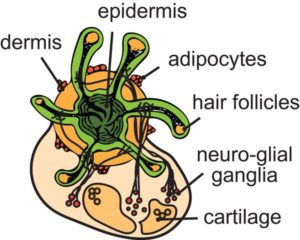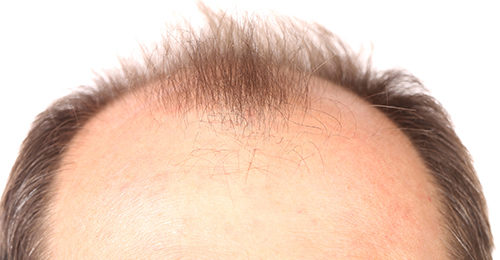Researchers say they have created the first hair-bearing human skin organoid made with pluripotent stem cells. The team published its research “Hair-bearing human skin generated entirely from pluripotent stem cells” in Nature.
The organoid’s development was led by Karl Koehler, PhD, formerly of Indiana University School of Medicine and now at Boston Children’s Hospital. An Oregon Health & Science University graduate student, Benjamin Woodruff, contributed by helping make the organoids as a post-baccalaureate research technician in the Stanford University lab of Stefan Heller, PhD.

“The skin is a multilayered organ, equipped with appendages (that is, follicles and glands), that is critical for regulating body temperature and the retention of bodily fluids, guarding against external stresses and mediating the sensation of touch and pain. Reconstructing appendage-bearing skin in cultures and in bioengineered grafts is a biomedical challenge that has yet to be met. Here we report an organoid culture system that generates complex skin from human pluripotent stem cells. We use stepwise modulation of the transforming growth factor β (TGFβ) and fibroblast growth factor (FGF) signaling pathways to co-induce cranial epithelial cells and neural crest cells within a spherical cell aggregate,” write the investigators.
“During an incubation period of 4–5 months, we observe the emergence of a cyst-like skin organoid composed of stratified epidermis, fat-rich dermis and pigmented hair follicles that are equipped with sebaceous glands. A network of sensory neurons and Schwann cells form nerve-like bundles that target Merkel cells in organoid hair follicles, mimicking the neural circuitry associated with human touch. Single-cell RNA sequencing and direct comparison to fetal specimens suggest that the skin organoids are equivalent to the facial skin of human fetuses in the second trimester of development. Moreover, we show that skin organoids form planar hair-bearing skin when grafted onto nude mice. Together, our results demonstrate that nearly complete skin can self-assemble in vitro and be used to reconstitute skin in vivo. We anticipate that our skin organoids will provide a foundation for future studies of human skin development, disease modeling and reconstructive surgery.”
“This makes it possible to produce human hair for science without having to take it from a human,” explained Woodruff, who now is completing his first year of cell and developmental biology graduate studies at OHSU. “For the first time, we could have, more or less, an unlimited source of human hair follicles for research.”
Having access to more hair-growing skin can help researchers better understand hair growth and development and maybe even provide clues needed to reverse a retreating hair line.



